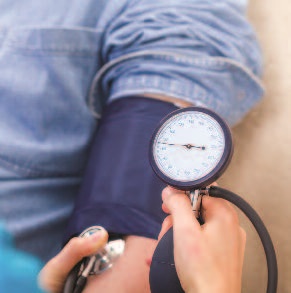News, views, and insights on maintaining a healthy edge.
 A New Line in the Sand
A New Line in the Sand
Is it possible to develop high blood pressure without seeing your blood pressure rise? The answer is yes. A team of experts assembled by the American College of Cardiology and the American Heart Association has concluded that the new cutoff should be 130-over-80. That immediately puts more than 30 million people in the U.S. into high blood pressure category. The most-affected group is men under the age of 45; the number of men who are “over the line” now triples. The good news is that the new cutoff does not mean that these folks will have to go on medication. The 130-over-80 number will more accurately identify individuals who are at a higher risk for stroke and heart attack—and hopefully a wake-up call to smokers and people who don’t get regular exercise.
 Danger Alert for TV Binge Watchers
Danger Alert for TV Binge Watchers
Doctors have been telling us for years to “get up off the couch” and exercise. Now they are telling us that this won’t do much good if we simply return to the couch. A study conducted by the University of Vermont on the TV-watching habits of more than 15,000 people has found those who say they watch “very often” are 1.7 times more likely to develop dangerous deep-vein blood clots. That in and of itself is hardly surprising. The eye-opening part of the study concerned middle-aged subjects; heavy TV-watchers in that age range who also got 150 minutes of exercise a week appear to have a slightly higher risk of DVT. Bad news for binge-watchers. Bad news for Netflix!
 Now Hear This
Now Hear This
Surgically implanted hearing aids have had a spotty history. Often they fail for the simplest reason: the middle ear is not a one-size-fits-all environment. At a December meeting of the Radiological Society of North America, researchers presented an exciting breakthrough that combines CT scans with 3D printing to produce custom-design implants for the middle ear, where three tiny bones (ossicles) transmit vibrations from the eardrum to the cochlea. Damaged ossicles are reconstructed with prostheses made of stainless steel and ceramics, which have a high failure rate. Dr. Jeffrey Hirsch, who authored the study, points out that the odds of getting a perfect fit are less than 1 in 1,000. In its first trial run, the CT+3D method had spectacular results. “This study highlights the core strength of 3D printing,” says Hirsch of the ability to very accurately reproduce anatomic relationships in space to a sub-millimeter level. “With these models, it’s almost a snap fit.”
 Is Chocolate a “SAD” Solution?
Is Chocolate a “SAD” Solution?
As spring creeps ever closer, the light is at the end of the tunnel for those who suffer from Seasonal Affective Disorder, aka SAD. To make it through these last few weeks, science offers some tools to keep up your spirits. Helping others can be a surprisingly uplifting experience, even if it’s not something you usually do. While volunteerism is at its peak around the holidays, by February and March there is a need for help at local shelters, food pantries, etc. Another option is 30 to 60 minutes of strenuous exercise, such as fast walking or aerobics. Exercising outdoors, even in cold weather, can boost your focus and reduce stress. New research also suggests that exercising under bright lights will have similar benefits. Even when not exercising, exposing yourself to bright light (such as a light box) for a half-hour a day has been shown to be effective for some people as anti-depressants. Here’s the best news: eat high-quality chocolate. It’s a proven mood booster and can relieve anxiety. We’re not talking about candy bars here—they may give you a quick pop, but may also contribute to negative feelings as you come back down.
 Double Trouble
Double Trouble
One of the many ways social media has changed our lives is through the spread of information on alternative cancer therapies. But has it changed our lives for the better? According to a study published in the Journal of the National Cancer Institute, people who choose alternative treatments for commonly curable cancers may double their risk of death. The authors defined “alternative” as a medical treatment administered by a non-medical person. Conventional therapies include chemo, radiation, and surgery. Patients who pursue non-medical options run the risk of allowing their cancers to spread to other parts of the body, including the lymph nodes. The study offers the example of stage-one breast cancer. With traditional treatment, a patient’s five-year survival rate is almost 100 percent. If that cancer is allowed to reach stage four, that survival rate is reduced to 25 percent. The study covered the most common cancers and looked at outcomes of 280 patients who chose alternative medicine versus the outcomes of 560 patients who went the traditional route.
 Is That Cigarette Really Worth Seven Years?
Is That Cigarette Really Worth Seven Years?
Whether we admit it or not, we all keep score as we age. We weigh our bad habits against our good ones and temper those estimates with what we know about our genetics. It’s an inexact science, to be sure…yet not as much as it used to be. University of Edinburgh researchers looked at the genetic makeup of 600,000 individuals from three different continents, zeroing in on genes related to lifestyle choices, including smoking, drinking, overeating and substance abuse. They were able to come up with a fascinating scoring system. For instance, people live an average of two months less for every kilogram they are overweight. Pack-a-day smokers shave off an average of seven years. The study also found that people live an average of 11 months longer for every year of schooling they have. Genes related to cholesterol levels and the immune system also appear to have a dramatic impact on life expectancy. The conclusion drawn by the researchers was that genes play a major role in determining life expectancy, but our lifestyle choices have a far greater impact than most people imagine.





